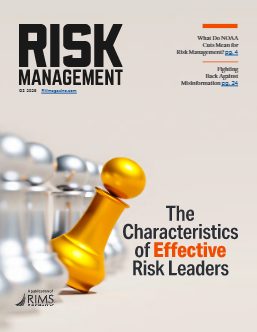Employer Obligations for Political and Discriminatory Speech in the Workplace
As the U.S. presidential election approaches, employers must balance respecting protected forms of speech while ensuring political discussion does not violate harassment and discrimination laws.
From Corner Office to Revolving Door: Managing Talent Risk with CEOs and Executive Leadership
To attract and keep the best executive talent, it is critical to focus on the risks of greatest concern to prospective leaders so the organization can mitigate them and maximize its competitive stance.
Building Operational Resilience in Third-Party Risk Management
This framework can help organizations move beyond traditional risk assessments with a systematic approach to truly building operational resilience.
The Role of Public-Facing Employees in Building Safety and Security
Public-facing workers can be first to identify behavior and irregularities on your premises, helping eliminate vulnerabilities or mitigate security risks before they start.
Current Issue

Second Quarter 2025
Understanding Premises Liability and ADA Compliance Requirements
Despite federal regulations related to accessibility, Many organizations still do not comply with these standards, presenting a significant and often underestimated liability.
Optimizing Your Enterprise Risk Management Strategy
As enterprise risk management continues evolving from a compliance exercise into a strategic advantage, these seven steps can help risk professionals enhance their organization’s ERM approach.
Protecting Employees Before, During and After a Disaster
To build true resilience, organizations should think of disaster recovery as a continuous cycle, preparing to respond and protect employees before, during and after a catastrophe.
Communicating Risk to the C-Suite
Keeping the C-suite and other business departments informed about risks to the organization can help them see beyond the headlines and assess risk in a broader strategic context.
Policyholder Considerations for Insurance Company Subrogation
Subrogation can hinder recovery after a loss, but policyholders can take these key steps to improve the claims process and boost the odds of favorable outcomes.
How Boards Can Navigate Geostrategic Risks
As rapidly changing geostrategic conditions are reshaping the business landscape, boards must integrate an informed global perspective on opportunities and risks into their work.
How to Take Your Company Global in an Unpredictable Environment
As companies enter new markets, these tips can help address key legal, tax and compliance challenges firms must overcome to ensure their growth is sustainable and risk resilient.
The Characteristics of Effective Risk Leaders
These habits can provide a guide for all risk professionals to “level-up” in their careers while also taking a more strategic approach to risk management within their organizations.
Reverse Discrimination Claims on the Rise
After recent legal decisions, reverse discrimination suits are likely to increase, but these key HR, legal and risk management tips can help reduce the risk.
Navigating the Legal Risks of a Remote Workforce
These tips can help employers navigate legal risks when implementing a remote or hybrid workforce model.
Learning Lessons from Cyber Insurance Claims
By showing vulnerabilities and areas for improvement, cyber claims can ultimately help organizations smooth their path to resilience.
The Potential Risk of Drone-Based Corporate Espionage
Advancements in drone technology have increased the possibility that they will be used in security breaches and data theft attacks.
Protecting AI Innovation: Why Trade Secrets are Outpacing Patents in IP Portfolios
AI presents novel challenges that often make patent protection challenging or even unavailable, leading many organizations to prefer pursuing trade secret designations.
What the Loss of NOAA’s Data Means for Insurance and Catastrophe Modeling
Cuts to NOAA's budget are not only impacting weather forecasting, they also weaken the industry's ability to accurately model and price catastrophic risk.
Securely Deploying Agentic AI
Agentic AI's ability to act autonomously presents an additional layer of governance challenges and unique security risks, but these best practices can help ensure safe, ethical deployment.
Leaders Increasingly Concerned About AI Adoption Risks
While more companies are adopting AI technology, business leaders are increasingly concerned about AI hallucinations, privacy or data breaches, and legal liability for misuse.
